Abomean Sisters Are Doing It For Themselves — And So Is Charles R. Saunders
Monday, May 26, 2008
posted by Steve Tompkins
 Print This Post
Print This Post
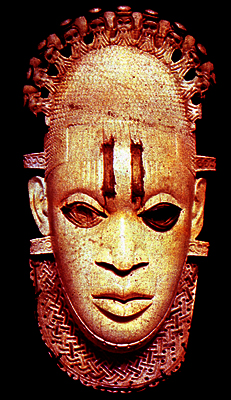
A champion is someone who gets up when he can’t. Charles Saunders, whose “Fists of Cross Plains” (which can be read at Damon Sasser’s REH: Two-Gun Raconteur website) is a blow-by-blow of a fanciful Robert E. Howard Heavyweight Championship staged, and ultimately upstaged by audience participation, in the Texan’s hometown, has earned that Dempseyism. The creator of Imaro of Nyumbani and Dossouye, she who was once an ahosi in the army of the Leopard King of Abomey, has had plenty of practice in shrugging off the slings, arrows, and belaying pins of outrageous publishing misfortune. Most recently, just as he promised in his TC interview last year, he has bounced back to his feet after being floored by the disappointment of Night Shade Books’ decision to give up on a relaunched Imaro series after just two installments, a Short Count to rival the infamous Long Count of the Dempsey/Tunney rematch. Saunders is now working with the most simpatico publisher he’s ever had, himself, and the first offering of that partnership is Dossouye, a “Sword-and-Soul epic” that can and should be ordered from lulu.com.
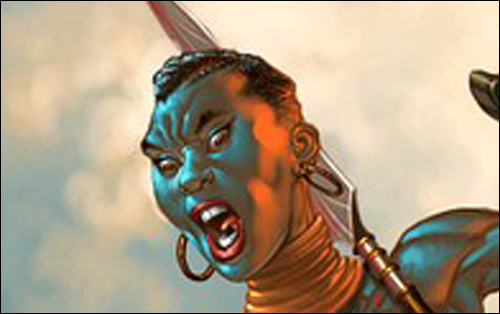
A cover illustration by Mshindo Kuumba electrifyingly realizes a passage like the following: “Weakened and injured though she was, the woman warrior could still deal death. Her gaze burned into his like that of a demon, and her teeth were bared in a snarl that combined pain, rage and hatred.” The tableau is the sword-and-sorcery iconography familiar since 1966 or 1967, an outnumbered sword-or-axe-wielder in king-of-the-mountain position atop a pile of combatants. But this time that champion is a black woman, a woman who is also black, and she’s there not because of any tokenism but by dint of the badassery documented within. The Night Shade covers for Imaro and The Quest for Cush were sedate by comparison; Kuumba’s future efforts when Sword & Soul Media gets around to, say, the fourth and fifth Imaro novels promise to be major events.
Saunders’ Ilyassai barbarian is a human wound, so much so that almost everything that befalls him in the three Eighties DAW novels is just more salt rubbed in. When we meet Dossouye in “Agbewe’s Sword,” she has long since inherited a feud that cost her parents her life, but even that fact underscores the extent to which, unlike the “son-of-no-father,” she knows who she is and where she belongs. As the novel opens that “where” has been invaded by the Abanti, “destroyers, not builders,” from the other side of the Gulf of Ubengi. The asuros of Abanti are known for their leopard-visaged helms and absolute intolerance of the very notion of female soldiers, and their new game-changer is a renegade sorcerer, “a bukur who could command the clouds as his army, with lightning as its spears.”
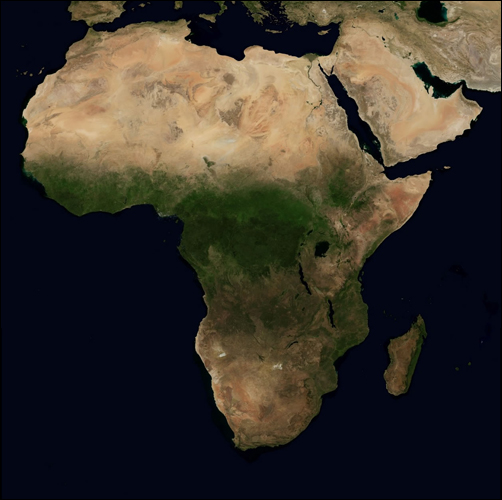
While the asuros make suitably villainous villains, this fantasticated Africa doesn’t seem to contain the equivalent of Nyumbani’s Naama — a center of radical, continent-coveting transhuman evil, like Acheron or Mordor. Of course Dossouye’s wanderings have only just begun, and Saunders does reveal that the past of her world was afflicted by an extra-continental menace that will have Imaro veterans thinking of the Mizungu War burned like a cicatrice across the collective memory of Nyumbani:
Hundreds of rains ago, the ships of the Wiribu had appeared suddenly, as though they were manifestations of vudunu. Nothing could withstand the power of their sorcery, and for many long, bitter rains, the people of Abomey and its neighboring lands had suffered under the Wiribu’s tyrannical rule. Periodic uprisings were crushed ruthlessly. Only when Nyansi bestowed the Sword to Agbewe were the Abomeans able to overcome the Wiribu’s vudunu and send them fleeing to their ships, never to be seen again, although a watch was kept for their return for many rains afterward.
In epic and heroic fantasy, a lapsed watch is always an invitation to further storytelling…
The “belonging” that so clearly differentiates Dossouye from Imaro is literalized in Abomey’s groves of “soul-keepers”:
Buried beneath the roots of each fedi-palm were thin wooden tubes, each of which contained an umbilical cord. Embodied within the cords were two of the three souls that were bestowed upon all Abomeans at birth. The selido joined them with their ancestors, and the semedo connected them with their extensive pantheon of deities and clan-spirits. The third soul, the djautau, was the soul of the individual, which died when the body died.

When uprooted, most human beings shriek like the “mandrakes torn out of the earth” of Romeo and Juliet. Saunders stresses how to be sundered from the “great spiritual continuum” of Abomean ancestors and compatriots is to be stripped of any chance for “status, property, and spouse,” and life not long after that. He leaves it for us to extrapolate such a trauma from Dossouye’s version of the west coast of Africa to the centuries of our own world’s history during which diaspora for many victims of the slave trade meant disensoulment, a terrible self-administered form of dehumanization that began well before they reached the shores where the auctioneers and overseers were waiting.
After an enemy in effect murders her selido and semedo, Dossouye fears that her third soul will die without the other two, rendering her “a zhumbi, a soulless creature, no longer human.” In fact, she becomes more human with each passing story. But exile is the only home left to her, for “if the Abomeans discovered that the woman who had saved them had lost her souls, yet continued to survive, they would be faced with the choice of either abandoning their belief in the conjunction of their three souls, a tradition they had held for rains beyond counting — or ridding themselves of the living contradiction that challenged the belief.”
So “the living contradiction” makes herself scarce, and, severed from her own ancestral support system in the forests beyond Abomey, goes on to function as a blade that slices through the roots and mystic memory-chords of other cultures. We saw something like this happen with an innocently bystanding tribe in the new novella (“The Afua” that Saunders added to the Night Shade version of Imaro, and it occurs again and again in Dossouye: false idols are shattered, false dogmas are overturned. One scene in “Shiminege’s Mask” can stand in for many: “In the girl’s face she saw the collapse of a lifetime of beliefs and assumptions. It was like watching the erosion of soil in the wet season.”
Oh, to have the marketing skills that would get this book, and the Imaros to follow from Sword & Soul Media, into the hands not just of subgenre supporters likely to visit sites like this one, but other potential readers starved for fantastic adventure because people who look like them are either underrepresented or misrepresented in too much modern fantasy. They would discover a natural, unforced authenticity, as in this from “Gimmile’s Songs”: “When she pulled off her close-fitting helmet, her uncut hair sprang outward in a kinky halo.”
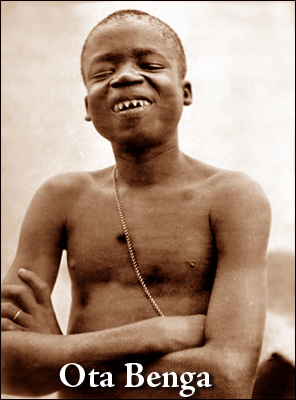
In “Obenga’s Drum,” Saunders doesn’t just write horror; he rights a horror, the real-life reduction to a sideshow attraction of the diminutive Ota Benga, a Batwa from near the Kasai River in what was then the Belgian Congo. Having survived the tender mercies of Leopold II’s colonizers, Ota Benga wound up exhibited in the Bronx Zoo. Still, just as the Imaro series never shied away from cruelties and crimes that were indigenous rather than arrivals from overseas, Dossouye recognizes that in certain times, in certain contexts, cultural relativism insults not only our intelligence but our humanity. Witness “Yahimba’s Choice,” which represented Saunders in the 2004 collection Dark Matter II: Reading the Bones. Anyone given to whining about the presence of Tina in “The Black Stranger” had best steer clear of this story, in which Dossouye confronts clitoridectomy, justified by the tribe she encounters on the basis of the belief that “if a man is stabbed by the dupa [the “dart” of flesh removed in a ceremony called akpona], he will die.” Akpona is phantasmally overseen by the Tarusi, specters with “eyes like circular pits of demon-fire” and “scores of tusk-like projections sprouting from their heads in place of hair” who are basic male fears come to half-life. Had this story, like earlier Dossouyes, appeared in one of Marion Zimmer Bradley’s old Sword & Sorceress volumes, its white heat would have made the paperbacks a fire hazard in every bookstore the DAW distributors reached.
As has been known to occur with writers who’ve been at it for decades, there is less flesh on the bones of Saunders’ style these days. He picks his spots, but such imagery as he chooses to employ is quite effective: “With the death of the dan-Ifete, their previous arrogance had been broken like a dry twig beneath the foot of an elephant.” An object discarded in a river sinks “with a splash, as infinitesmal as the ranting of women and men against the gods.” His newer action scenes are more like short sharp shocks than the pulverizing, pulp-outdoing brawls of Imaro’s (first) heyday. He’s confident enough to cut away from the bearding of Umenya Kwi, a vampiric sichi, in its den by Dossouye and Gbo, in “Shimininege’s Mask,” having other priorities — although more backstory on the ouster of the sichis from the cities of men would have been welcome. Gbo the war-buffalo, whose forbears were bred for “a veneer of tractability” and whose multi-purpose “whuffs” elevate him to the status of a far bulkier Bucephalus or Trigger, deserves special mention. Again and again the horns of Dossouye’s various dilemmas are no match for the horns of Gbo.
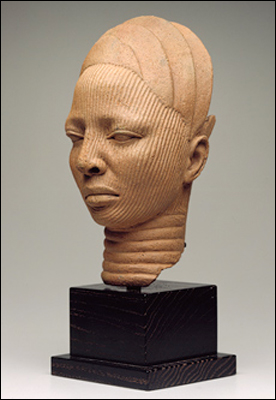
Some of the readers upon whom Saunders should have been able to depend held off on ordering the 2006 and 2007 Imaro and Quest for Cush because they already owned the original DAW paperbacks of those novels, and were waiting for the saga to come to the end of The Trail of Bohu and enter never-before-published territory. A snit about trade paperbacks may have played its part in a few cases. And it is possible that still others sat on the fingers that should have been mouse-clicking because of an afterword appended by an individual with a reputation for prose as excruciating as the “Is it safe?” scene in Marathon Man. Dossouye affords all such malingerers a shot at redemption as well as readerly gratification. If you already know, or are willing to entertain the possibility that, the mother continent is a motherlode of mythological resources, this one’s for you. If you claim sword-and-sorcery aficionado credentials, but don’t support Charles Saunders’ return to the subgenre, Legba, “the god of apostates and defilers” will be visiting you in the wee small hours.
